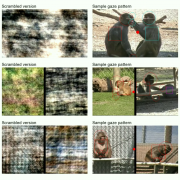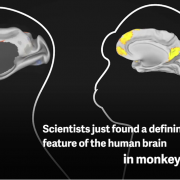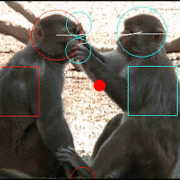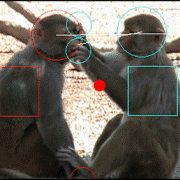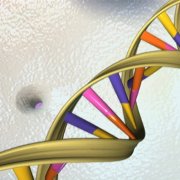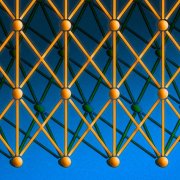May 26, 2017 - 4:00 pm
"We humans think we're so special. To determine what sets us apart from the rest of the animal world, scientists investigate features that might be uniquely human, such as self-awareness or language.
But every now and then, a new finding throws the narrative, leaving us to wonder what those truly unique human traits really are. In a new study, neuroscientists have knocked down another assumption by discovering a network in the monkey brain that'...
May 26, 2017 - 4:00 pm
Kevin Murphy (Google Research)
Host: Josh Tenenbaum
Abstract: In this talk, I summarize some recent work in my group related to visual scene understanding and "grounded" language understanding. In particular, I discuss the following topics:
Our DeepLab system for semantic segmentation (PAMI'17, https://arxiv.org/abs/1606.00915).
Our object detection...
Our DeepLab system for semantic segmentation (PAMI'17, https://arxiv.org/abs/1606.00915).
Our object detection...
May 26, 2017 - 3:45 pm
Bret Stetka | Scientific American - Neuroscience
May 18, 2017
"For many hours a day they pluck dirt, debris and bugs from each other’s fur. Between grooming sessions they travel in troops to search for food. When ignored by mom, they throw tantrums; when not ignored by zoo-goers, they throw feces.
Through these behaviors, monkeys demonstrate they understand the meaning of social interactions with other monkeys. They recognize when their peers...
What makes us human? Scientists just found a defining feature of the human brain in monkeys [QUARTZ]
May 25, 2017 - 3:15 pm
"A new look inside monkeys brains is forcing researchers to reconsider what makes humans unique, as you can see in the video above.
It’s no surprise that humans and many types of monkeys have a lot in common; we’re both social creatures and share about 93% of our DNA. But when scientists from The Rockefeller University peeked inside four rhesus monkeys’ brains with an fMRI machine, they were still surprised to find something they’ve only ever...
May 24, 2017 - 3:30 pm
"Monkey brains have sections dedicated solely to social interactions, a new finding that researchers say could help us better understand the human mind.
Scientists scanning the brains of rhesus macaques found that certain parts were active when the monkeys watched videos of social interactions between other monkeys, but that same network was largely inactive in response to other images. A study in the journal Science said those brain regions...
May 23, 2017 - 4:15 pm
"Primates are intensely social species. We smoothly maneuver in our social environment by effortlessly understanding our peers' encounters. But what is the neural circuitry that is engaged when primates perceive such scenes of social interactions? By using functional magnetic resonance imaging, we found three networks in the monkey brain engaged in processing social interactions, and discovered that one of them is exclusively dedicated to this...
May 23, 2017 - 3:45 pm
"What is the social network of the brain" [Google Translate]
"Социальная жизнь – настолько обширное и сложное явление, что было бы странно, если бы для нее в мозге не было специальных зон. Они и впрямь есть, причем разными аспектами социальной жизни занимаются разные структуры.
Отдельные нейронные цепи срабатывают тогда, когда индивидуум получает удовольствие от общения – таким нейронным цепям, в частности, была посвящена работа исследователей...
May 19, 2017 - 3:30 pm
"Parallels to humans: How monkeys process social interactions neuronal" [Google Translate]
Listen to the radio broadcast interview recording (German) of Winrich Friewald on Deutschlandfunk's website using the link below.
May 18, 2017 - 4:00 pm
"Scientists call our ability to understand another person’s thoughts—to intuit their desires, read their intentions, and predict their behavior—theory of mind. It’s an essential human trait, one that is crucial to effective social interaction. But where did it come from?
Working with rhesus macaque monkeys, researchers in Winrich Freiwald’s Laboratory of Neural Systems at The Rockefeller University have discovered tantalizing clues about the...
May 18, 2017 - 3:15 pm
"Neural circuitry lets macaques figure out what's going on in social interactions
For many hours a day they pluck dirt, debris and bugs from each other’s fur. Between grooming sessions they travel in troops to search for food. When ignored by mom, they throw tantrums; when not ignored by zoo-goers, they throw feces.
Through these behaviors, monkeys demonstrate they understand the meaning of social interactions with other monkeys. They recognize...
May 15, 2017 - 8:00 am
This meeting is invitation only.
May 8, 2017 - 1:15 pm
By Eric S. Lander and Eric E. Schmidt May 5
Eric S. Lander is president and founding director of the Broad Institute of MIT and Harvard University. Eric E. Schmidt is the executive chairman of Alphabet, the parent company of Google.
For more than a half century, the United States has operated what might be called a “Miracle Machine.” Powered by federal investment in science and technology, the machine regularly churns out breathtaking advances....
May 5, 2017 - 4:00 pm
Erik Brynjolfsson (MIT)
Title: What Can Machines Learn, and What Does It Mean for Occupations and Industries?
Abstract: This talk will present a preliminary framework and approach for understanding the potential effects of machine learning (ML) on tasks, occupations and industries. Digital technologies have already had a...
Abstract: This talk will present a preliminary framework and approach for understanding the potential effects of machine learning (ML) on tasks, occupations and industries. Digital technologies have already had a...
April 21, 2017 - 4:00 pm
Jacob Feldman (Rutgers)
Title: Perceptual Organization From a Bayesian Point of View
Abstract: Perceptual organization is the process by which the visual system groups the visual image into distinct clusters or units. In this talk I'll sketch a Bayesian approach to grouping, formulating it as an inverse inference problem...
Abstract: Perceptual organization is the process by which the visual system groups the visual image into distinct clusters or units. In this talk I'll sketch a Bayesian approach to grouping, formulating it as an inverse inference problem...
April 19, 2017 - 1:45 pm
Larry Hardesty | MIT News Office
April 14, 2017
"In the past 10 years, the best-performing artificial-intelligence systems — such as the speech recognizers on smartphones or Google’s latest automatic translator — have resulted from a technique called 'deep learning.'
Deep learning is in fact a new name for an approach to artificial intelligence called neural networks, which have been going in and out of fashion for more than 70 years. Neural...



